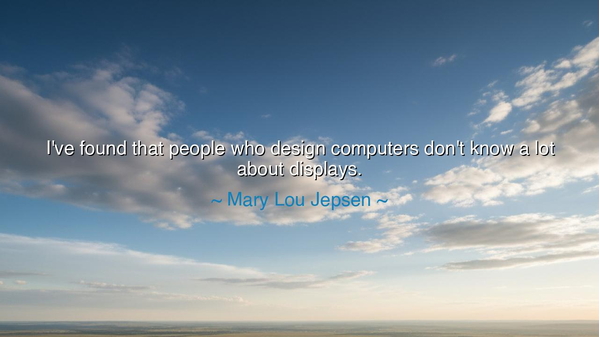
I've found that people who design computers don't know a lot






There is a quiet wisdom hidden within the words of Mary Lou Jepsen, a visionary of light and invention: “I’ve found that people who design computers don’t know a lot about displays.” To the unthinking ear, this may sound like a mere observation of technical divisions — of engineers and their specialties. But to the wise, it is a parable about perception and understanding, about the distance that often lies between the mind that builds and the eye that beholds. In her words, Jepsen speaks not only of technology but of life itself: that too often, those who design the inner workings of things forget the human experience that meets them at the surface.
In the ancient times of craft and architecture, the builders of temples knew that form and function must be one. The mason who carved the stone also understood the light that would fall upon it, the way dawn would strike its edge or shadow its base. But as ages passed and knowledge divided into many branches, a great forgetting took place. The thinker turned from the artist, the designer from the seer. So it was in Jepsen’s time: the computer engineers mastered circuits, code, and logic — yet few paused to understand the display, the living window through which humans touched their creation. For what is a computer without its screen, if not a soul without eyes?
Mary Lou Jepsen herself was among those rare spirits who sought to bridge this divide. As a pioneer of display technology, she worked on One Laptop per Child, striving to bring light — quite literally — to the world’s poorest classrooms. She looked not only at pixels and voltages, but at how light travels, how color breathes, how a child’s eyes perceive wonder. She saw that in many laboratories, engineers built machines of staggering intelligence, yet neglected the art of seeing — of how the world is revealed to the human gaze. Her statement, then, was both a critique and a calling: that innovation without empathy is blindness, and brilliance without beauty is incomplete.
Think also of Leonardo da Vinci, who in his time refused to divide art from science. He painted the light as he studied its physics; he built machines as he pondered their grace. To him, sight was sacred — the meeting of the human soul and the outer world. In Jepsen’s lament, one hears the echo of Leonardo’s belief: that true design must join the mechanical with the perceptual, the functional with the poetic. To design a computer and neglect the display is to make a heart without a face, a mind without a mouth. The ancients would have called such work half-born — clever, but not yet wise.
There is also humility in her words. For she does not condemn, but reminds: each of us knows deeply one part of the world, but rarely the whole. The engineer, in his mastery of logic, may forget the play of color and texture; the artist, in her passion for beauty, may ignore the gears that make it possible. Thus, the greater calling is to see beyond one’s domain, to learn the language of another discipline, another soul. The future belongs not to the narrow expert, but to the bridge-builder — the one who can join mind and heart, machine and light.
From her insight arises a broader lesson for all: whatever you build, remember the human eye that will behold it. Whether you craft machines, words, or systems, think not only of their inner workings but of how they are seen, touched, and felt. The truest creation is that which speaks both to reason and to the senses, that which is understood not just by the mind but by the heart. Seek, then, the wholeness of creation — where every invention serves both function and feeling.
So let these words of Mary Lou Jepsen be as a lantern for the generations to come: do not divide what was meant to be united. The display and the computer, the vision and the design, the art and the science — all are parts of one great whole. Walk, therefore, in balance. Be the builder who sees, the thinker who feels, the creator who listens. For the world will always need not just those who make light, but those who understand it. And when you work, remember: what you create is not only for machines — it is for eyes, for hearts, for souls.






AAdministratorAdministrator
Welcome, honored guests. Please leave a comment, we will respond soon